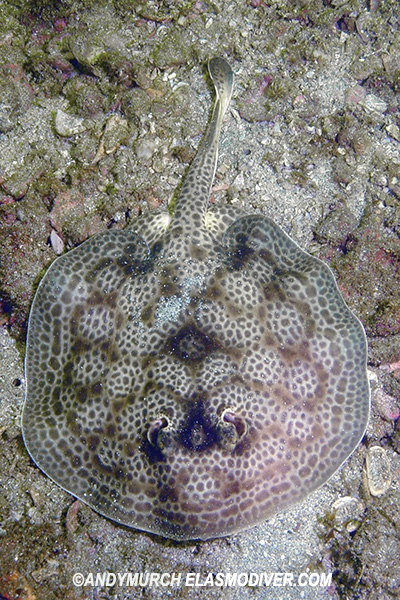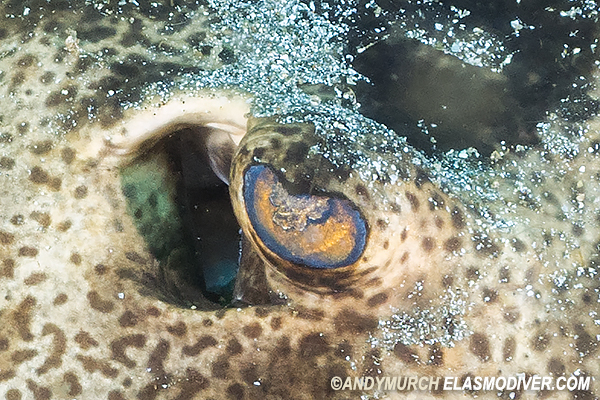


View all available
Leopard Round Stingray Pictures in the
Shark Pictures Database
Common Names: Leopard
round stingray.
Latin Name:
Urobatis pardalis.
Family:
Urobatidae.
Identification:
Circular body disc. No dorsal fins. Tail shorter than disc
length. Total length of body and tail equal to 1.5-1.6 times disc width. Sting present on tail. Dorsum smooth (no tubercles).
Colour somewhat
variable: base colour grey/tan with irregular dark spots. Underlying dusky
blotches often form a subtle honeycomb pattern. Dark spots may be very small or
as large as pupil. Spots may merge to form elongated spots and whirls. Ventrum pale.
Tail short and stout. Tail spine present. Spiracle length 1.3 to 1.6 times
longer than eye diameter. Pupil shade/flap has 3 rounded
points. Pupil shade and iris golden or tan.
Size:
Maximum recorded length 46cm.
Max length will likely be increased after further studies.
Habitat:
Intertidal to at least 20m on reefs and sandy
substrates
(personal observation).
Distribution:
Eastern
Tropical Pacific. Costa Rica to Columbia.
Behavior:
Probably nocturnal.
Remains
motionless when observed on reefs during the day.
Reproduction:
Ovoviviparous.
Conservation Status:
Described in 2015, the leopard round stingray has
not yet been assessed by the IUCN. From personal observations in Costa Rica and
Panama, this species does not appear to be as common as its closely related
cousin Urobatis halleri that is abundant in Pacific Mexico and California.
Photographs:
Upper image (adult
animal) Isla Coiba, Panama. Lower image (juvenile animal)
Islas Catalinas, Costa Rica, Tropical Eastern Pacific.
Similar species:
The range of
Haller's round stingray
Urobatis halleri may overlap
with that of H.pardalis. These rays are difficult to tell
apart because their shape is extremely similar and their markings are highly
variable but U.halleri generally displays smaller, more uniform and more
closely spaced light and/or dark spots on a diffuse honeycomb background.
Reaction to divers:
Easily approached with
slow movements.
Diving logistics:
COSTA RICA - I dove with these rays from a dive boat run by Agua
Rica Dive Shop out of Tamarindo, Costa Rica. The dive sites around Las Islas
Catalinas are also a good place to find schooling Cownose rays, Bulls-eye
electric rays and the
occasional reef whitetip shark . The dive shops
in Playas del Coco (to the north) also run charters to these sites.
PANAMA - I have encountered Leopard round stingrays all around
Isla Coiba and at Isla Iguana. Any of the numerous dive centers in Santa
Catalina can transport you to Coiba on single and multi-day trips.
Interestingly, in the sheltered lagoon behind Punta Chame this
species was absent; being replaced by an abundant population of
Urotrygon
rogersi.
Citations:
Nueva especie del género Urobatis (Myliobatiformes:
Urotrygonidae)
del Pacífico oriental tropical
Luis Fernando Del Moral-Flores1, 2, Arturo Angulo3, Myrna I. López3, 4 &
William A. Bussing3, 4
























